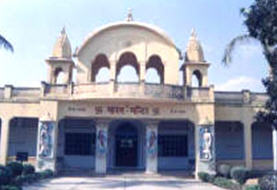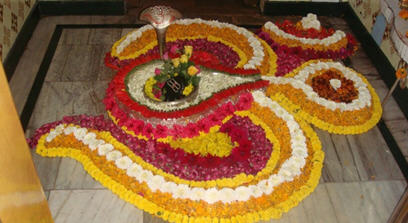Rishikesh is 24 kilometers away from Haridwar, and 245 km northeast of Delhi. It is the place where the clear Ganges leaves the Himalaya Mountains. Rishikesh is good place to stay for a while during the hot months of April to August. Rishikesh is famous as a place to study yoga and meditation, and there are many ashrams here. It became famous when George Harrison and Beatles came here in the 60s.
It is said that Bharata, the brother of Lord Rama, did severe penance here. A temple of Bharata was constructed at this site, and the town of Rishikesh grew up around it.
The town got its name from the time when Lord Hrishikesh, Vishnu, appeared here to grant darshan to Raibhya Rishi when he was performing austerities. The demons Madhu and Kaitabha were also killed here by Lord Vishnu as Hayagriva.
How Madhu And Kaitabh Were Killed Here in Rishikesh
The avatar of Hayagriva Bhagavan took place to restore the Vedas to Brahma. Lord Vishnu had taught Brahma the creation through His breath of Vedas. Brahma became extremely proud and head strong of his position as the creator and about his powers. Sriman Narayana as usual wanted to remove Brahma’s pride. Due to Lord’s desire , then a couple of water droplets from the lotus seat of the Lord incarnated as two Asuras, Madhu and Kaitabha;, one demon (kaitabh) was of tamo guna and the other (madhu) was of rajo guna. They both stole the Vedas from Brahma.
Unable to carry on his work of creation without the Vedas, Brahma rushed to the Lord and pleaded Lord Narayana for mercy and saving Vedas. Seeing Brahmaji humbled, Lord Narayana incarnated as Hayagriva, as the white Horse faced to destroy the Asuras and restore the Vedas to Brahma. The Divya tejas Sattva murthy Sri Hayagriva thus, in a grandest beautiful manner rushed to Patalaloka and raised His transcendental sound and terrified Madhu and Kaitaba. Afraid, they hid the Vedas (which were in the form of babies) and ran away from the scene. Sri Hayagriva handed over the Vedas to Brahma and went back. Returning back with restored confidence, Madhu kaitaba searched for the sound which terrified them earlier but found the Source of sound as well as their stolen Vedas missing. Angered,They both again rushed to Brahma to take revenge. Brahma in turn was terribly scared and sought the help of Lord. Sri Hayagreevar appeared to fight with asuras and killed them. Brahma re-continued his work of creation.
That is why Lord is also called as Madhusudhana. (for having killed madhu and kaitabha).
Another name of Hrishikesh mentioned in scriptures is also “KUBJAMRAK TIRTH.” Here is the description of how Kubjamrak tirth derived its name. Lord Varaha told Prithvi- “In Satya Yuga, at the time when the earth was still submerged in water, I had killed two mighty demons named Madhu and Kaitabh. After killing both the demons I looked all around and found sage Raibhya engrossed in his penance. Sage Raibhya was a great devotee of mine. I was extremely impressed and watched him hiding myself behind a mango tree. The mango tree could not bear the weight of my hands and became curved. This is how Kubjamrak tirth derived its name. Very soon, sage Raibhya found out that I was hiding behind that mango tree. He eulogized me and requested me to grant a special status to Kubjamrak tirth among all the holy places. I blessed him and thus Kubjamrak tirth became one of the holiest places. There are several other holy places situated in the vicinity of Kubjamrak tirth, Manas tirth, Maya tirth, Sarvakamik tirth, Purnamukh tirth, Agni tirth, Shukra tirth, Manasar tirth, Sapta samudrak tirth, etc. All these holy places including Kubjamrak tirth are capable of giving salvation to a man.”
Places to Visit in Hrishikesh
Bharata Temple

One of the main temples is the Bharata temple in the central part of town, despite the name, the presiding deity is of Lord Narayana, not Bharata, Lord Rama’s elder brother. This temple is only a half kilometer from Triveni Ghat, the main bathing ghat in town. There is an inscription on the temple that says Adi Sankaracarya renovated the temple. Darshan times are 5-11 am and 1-9 pm.
Lakshman Jhula

The Lakshmana Jhula area is only three kilometers upstream from Rishikesh, a pleasant walk away. This is where Lord Rama’s brother, Lakshmana, performed penance, commemorated by the Lakshmana temple. Temple is on the west bank of the river by the bridge. Near this temple at Rishi Kund is said to be where Lord Rama and Lakshmana took bath to purify themselves from killing the demon Ravana, who was also a brahmana.
There was a hanging jute rope bridge here until 1889. It was rebuilt with iron cables in 1939. On the other side of the bridge there are many temples. There are nice small waterfalls about 3 ½ km north of Lakshman Jhula, on the east bank of the river. There are also nice sandy beach where you can bathe in the Ganges. It is just south of the bridge, on the other side of the river from the main part of town.
Triveni Ghat,
The main bathing ghat, is where the Ganges and the subterranean Yamuna and Saraswati are said to flow together. Dawn is a good time to come here, during which time people make offerings to the Ganges and feed the large fish here. Pinda sraddha, or offerings for the benefit of dead ancestors, is performed here. There is a daily evening Ganges Arati (offering of lamps) at around 6 pm. It is a well-attended, interesting event.

At Muni-Ki-Reti (abode of the Rishis) the Ganges emerges out of the Himalayan foothills. The Shatrugna Temple, Muni ki-Reti, is about 4.5km from downtown Rishikesh. It is dedicated to Shatrugna, the youngest brother of Lord Rama.
North of the Bharata temple beyond the Chandrabhaga River is the Balaji and Chandramouleswara temple. The architecture is in the South Indian style and it is managed by the board of the famous Tirupati temple in South India.
Neela Kantha Mahadeva Temple

Neela Kantha Mahadeva Temple is situated on a hill, 1,700m (5,500 ft) above sea level, and is about 11 km from Laksman Jhula. This is an important Shiva temple. Shiva received the name Neela Kantha after he drank the poison produced from the churning of the Milk Ocean, after drinking the poison his throat turned blue. Neela means “blue” and kantha means “throat. It takes about four hours to reach here from Laksman Jhula and less than two hours to walk back. If it is hot it is best to walk early in the day. The path to the temple starts behind Swarg Ashram and then goes past Mahesh Yogi’s ashram. There are regular shared jeeps to this temple from Laksman Jhula. It is especially busy during July, which is said to be the time when Siva drank the poison. There is a holy tree here that women tie a string to as an offering in order to get blessed with a child.
From the Neela Kantha temple you can climb 2km to the Parvati temple, which is located on top of a high hill. From the Parvati temple another 2km further up the hill is a Cave (gufa), where there is a small temple. There are good views along the way. It is a fairly hard climb to the Parvati temple and a fairly easy walk to the cave.
Kunjapuri

It is a 10km walk to this Shakti temple, which is located on a hill north of Rishikesh. From this temple there are great views of the surrounding Himalayan countryside. To get here you can take a bus to Hindola Khal on the road to Tehri, and then from there it is a 3km walk. It is a 45 minutes bus ride from Rishikesh.
Going To See The Char Dham Temples
From Rishikesh there are many important holy places we will want to visit, such as Badrinath, Gangotri (near the source of the Ganges), Kedarnath, and Yamunotri (near the source of the Yamuna River). This is called the “Char Dhama” or four shrines pilgrimage tour. There will be many other holy towns you will travel through and where you may want to stop. There are also seven holy rivers in this area, which include the Alakananda, Bhagirathi, Dhauli Ganga, Mandakini, Pindar Ganga, the Nagar, and others. These rivers form five important sanganis or confluences where they meet. Some pilgrims bathe in all five sanganis before having darshan at Badrinath.